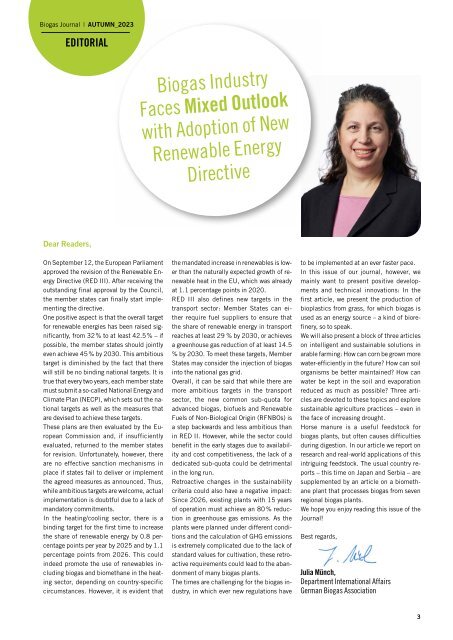Autumn 2023 EN
The German Biogas Association presents its autumn 2023 issue of the English BIOGAS journal.
The German Biogas Association presents its autumn 2023 issue of the English BIOGAS journal.
- No tags were found...
You also want an ePaper? Increase the reach of your titles
YUMPU automatically turns print PDFs into web optimized ePapers that Google loves.
Biogas Journal | AUTUMN_<strong>2023</strong><br />
EDITORIAL<br />
Biogas Industry<br />
Faces Mixed Outlook<br />
with Adoption of New<br />
Renewable Energy<br />
Directive<br />
Dear Readers,<br />
On September 12, the European Parliament<br />
approved the revision of the Renewable Energy<br />
Directive (RED III). After receiving the<br />
outstanding final approval by the Council,<br />
the member states can finally start implementing<br />
the directive.<br />
One positive aspect is that the overall target<br />
for renewable energies has been raised significantly,<br />
from 32 % to at least 42.5 % – if<br />
possible, the member states should jointly<br />
even achieve 45 % by 2030. This ambitious<br />
target is diminished by the fact that there<br />
will still be no binding national targets. It is<br />
true that every two years, each member state<br />
must submit a so-called National Energy and<br />
Climate Plan (NECP), which sets out the national<br />
targets as well as the measures that<br />
are devised to achieve these targets.<br />
These plans are then evaluated by the European<br />
Commission and, if insufficiently<br />
evaluated, returned to the member states<br />
for revision. Unfortunately, however, there<br />
are no effective sanction mechanisms in<br />
place if states fail to deliver or implement<br />
the agreed measures as announced. Thus,<br />
while ambitious targets are welcome, actual<br />
implementation is doubtful due to a lack of<br />
mandatory commitments.<br />
In the heating/cooling sector, there is a<br />
binding target for the first time to increase<br />
the share of renewable energy by 0.8 percentage<br />
points per year by 2025 and by 1.1<br />
percentage points from 2026. This could<br />
indeed promote the use of renewables including<br />
biogas and biomethane in the heating<br />
sector, depending on country-specific<br />
circumstances. However, it is evident that<br />
the mandated increase in renewables is lower<br />
than the naturally expected growth of renewable<br />
heat in the EU, which was already<br />
at 1.1 percentage points in 2020.<br />
RED III also defines new targets in the<br />
transport sector: Member States can either<br />
require fuel suppliers to ensure that<br />
the share of renewable energy in transport<br />
reaches at least 29 % by 2030, or achieves<br />
a greenhouse gas reduction of at least 14.5<br />
% by 2030. To meet these targets, Member<br />
States may consider the injection of biogas<br />
into the national gas grid.<br />
Overall, it can be said that while there are<br />
more ambitious targets in the transport<br />
sector, the new common sub-quota for<br />
advanced biogas, biofuels and Renewable<br />
Fuels of Non-Biological Origin (RFNBOs) is<br />
a step backwards and less ambitious than<br />
in RED II. However, while the sector could<br />
benefit in the early stages due to availability<br />
and cost competitiveness, the lack of a<br />
dedicated sub-quota could be detrimental<br />
in the long run.<br />
Retroactive changes in the sustainability<br />
criteria could also have a negative impact:<br />
Since 2026, existing plants with 15 years<br />
of operation must achieve an 80 % reduction<br />
in greenhouse gas emissions. As the<br />
plants were planned under different conditions<br />
and the calculation of GHG emissions<br />
is extremely complicated due to the lack of<br />
standard values for cultivation, these retroactive<br />
requirements could lead to the abandonment<br />
of many biogas plants.<br />
The times are challenging for the biogas industry,<br />
in which ever new regulations have<br />
to be implemented at an ever faster pace.<br />
In this issue of our journal, however, we<br />
mainly want to present positive developments<br />
and technical innovations: In the<br />
first article, we present the production of<br />
bioplastics from grass, for which biogas is<br />
used as an energy source – a kind of biorefinery,<br />
so to speak.<br />
We will also present a block of three articles<br />
on intelligent and sustainable solutions in<br />
arable farming: How can corn be grown more<br />
water-efficiently in the future? How can soil<br />
organisms be better maintained? How can<br />
water be kept in the soil and evaporation<br />
reduced as much as possible? Three articles<br />
are devoted to these topics and explore<br />
sustainable agriculture practices – even in<br />
the face of increasing drought.<br />
Horse manure is a useful feedstock for<br />
biogas plants, but often causes difficulties<br />
during digestion. In our article we report on<br />
research and real-world applications of this<br />
intriguing feedstock. The usual country reports<br />
– this time on Japan and Serbia – are<br />
supplemented by an article on a biomethane<br />
plant that processes biogas from seven<br />
regional biogas plants.<br />
We hope you enjoy reading this issue of the<br />
Journal!<br />
Best regards,<br />
Julia Münch,<br />
Department International Affairs<br />
German Biogas Association<br />
3

















